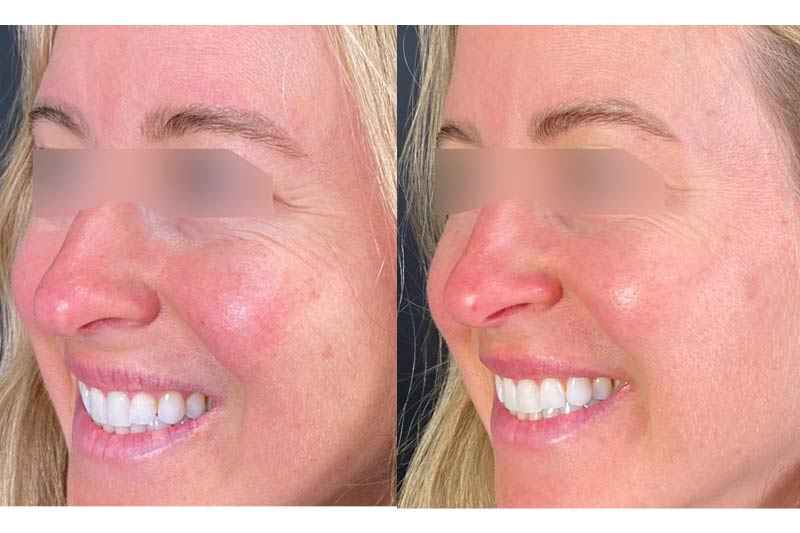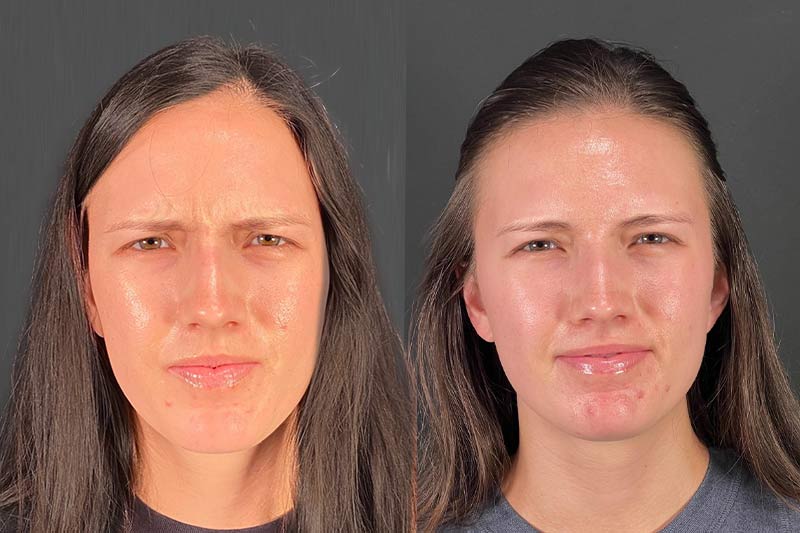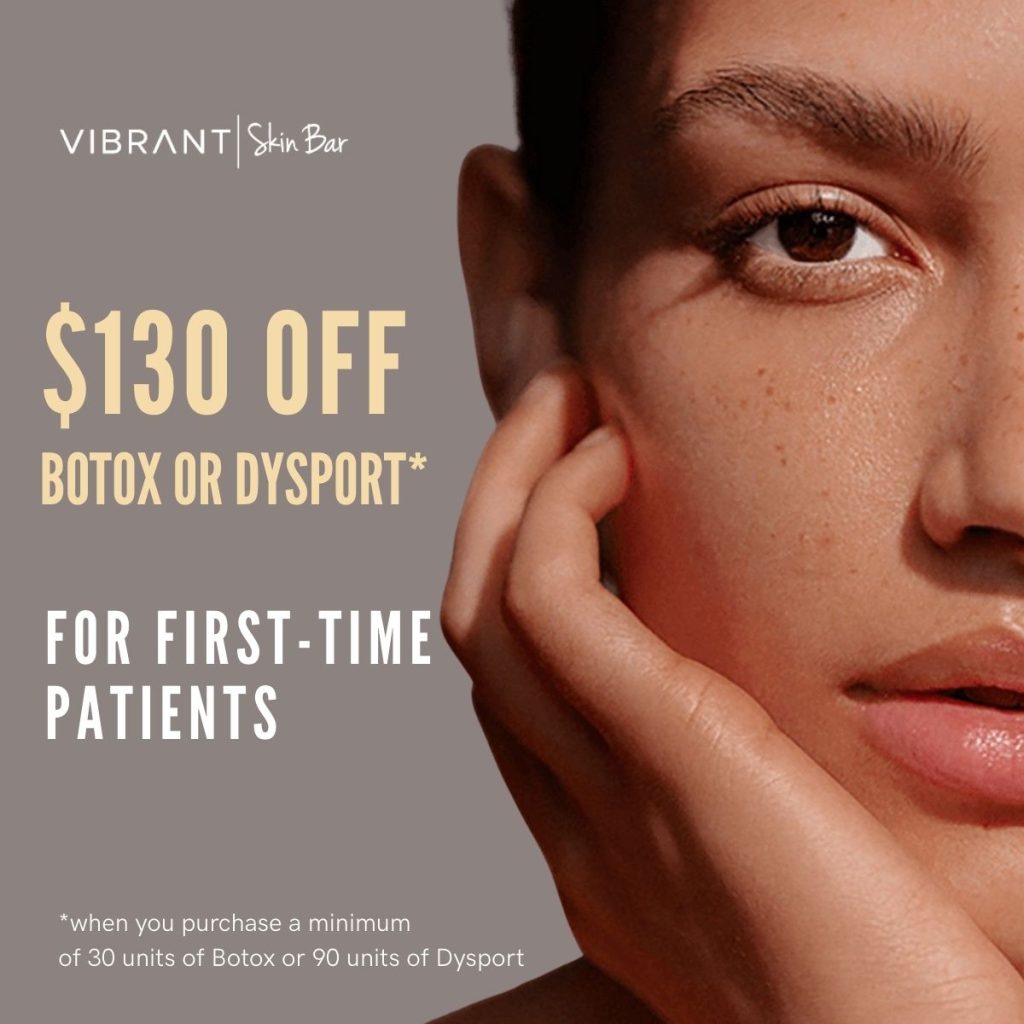Botox and Dysport are the two most common neurotoxins med spas and clinics use to reduce wrinkles and fine lines. They also have applications in the treatment of various medical conditions caused by muscle overactivity.
Botox injections are more well-known among cosmetic enthusiasts. But what is Dysport? How similar are Botox and Dysport and can they be used interchangeably?
This article explores the differences and similarities between Dysport and Botox, helping you prepare for your wrinkle-erasing treatment.

What Is Dysport?
Dysport is a neurotoxin derived from the bacterium Clostridium botulinum used as an injection to treat wrinkles. The FDA approved the injectable to treat glabellar lines (vertical lines between the eyebrows) in adults over 18.
What Is Botox?
Like Dysport, Botox is a botulinum toxin injection used to reduce the appearance of facial wrinkles. The FDA approved it to treat glabellar lines, forehead lines, and crow’s feet.
What Are the Differences Between Dysport and Botox?
Botox and Dysport serve the same cosmetic purpose: freezing facial muscles to prevent wrinkle formation. The following information shows how these two injectables differ, helping you choose the right treatment for your aesthetic goals.
| Dysport | Botox | |
|---|---|---|
| What is it? | Injectable made from a small amount of botulinum toxin. | Injectable made from a small amount of botulinum toxin. |
| Treatment areas | Glabellar lines. | Glabellar lines, crow’s feet, forehead lines. |
| The results’ longevity | Up to six months. | Up to six months. |
| Side effects | Mild bruising, redness, pain. | Bruising, tenderness, redness, pain, headache. |
| Aftercare | Avoiding strenuous activities, sun exposure, bending down, and applying pressure to the treatment area. | Avoiding strenuous activities, sun exposure, bending down, and applying pressure to the treatment area. |
| Downtime | No downtime. | No downtime. |
| Cost | $4.50 per unit. | $13.50 per unit. |
Dysport vs. Botox Treatment Areas
Dysport is currently approved for one treatment area, while there are three Botox areas that are FDA approved.
Dysport
- Glabellar lines
Botox
Both products also treat other areas in off-label procedures, when the medical provider determines they can benefit the patient. Those areas include:
- Chin wrinkles
- Bunny lines
- Eyebrows
- Lines around the mouth
- Neck wrinkles
Note: Read our article and find out what you need to know about the Botox brow lift and neck Botox.
What Are the Benefits of Dysport and Botox?
Repetitive facial expressions, such as laughing and frowning, cause dynamic wrinkles over time. When the production of collagen and elastin declines, which naturally occurs with aging, the skin loses elasticity and can’t revert to its original position after stretching and creasing. That’s where Dysport and Botox come into play, providing the following benefits.
- Reduced dynamic wrinkles – Botulinum toxin blocks the release of a neurotransmitter signaling the muscles to contract. When this signal is interrupted, the targeted muscles relax, smoothing the overlying skin.
- Slimmer jawline – Neurotoxins are often used in off-label procedures to relax overactive masseter muscles responsible for chewing and talking, resulting in a more contoured, slimmer jawline.
- Improved gummy smile – Dysport and Botox are also used off-label to improve a gummy smile – the condition where the upper lip lifts too high during smiling and exposes more gum tissue than desired.
- Rejuvenated appearance – By smoothing wrinkles, Dysport and Botox provide a more youthful look.
- Quick procedure – Patients can schedule Botox and Dysport during the lunch hours at work.
- No downtime – Neurotoxin injectables are a convenient treatment before important events because they require no downtime.
Do Dysport and Botox Require Special Preparation?
Dysport and Botox don’t require special preparation, apart from the general guidelines that providers recommend for most cosmetic treatments to reduce the risk of swelling, bruising, and irritation.
The recommendations include refraining from alcohol and nicotine, drinking plenty of water, and avoiding harsh skincare products, such as retinol and glycolic acid. Some patients may need to discontinue the use of medications, such as blood-thinners, allergy drugs, and muscle relaxants.
Dysport vs. Botox Procedure
Botox and Dysport injectables work the same way. The medical practitioner disinfects the treatment area, applies a topical anesthetic, and injects the neurotoxin, inhibiting the underlying muscles’ ability to contract and cause wrinkles. The skin that covers the muscles relaxes, leading to a smooth, wrinkle-free complexion.
The injection takes only a few minutes. The whole procedure may last about half an hour, depending on how long it takes the anesthetic to numb the treatment area.
No recovery time is needed after Botox or Dysport treatment. Patients can immediately continue with their daily activities.
Dysport vs. Botox Results
Dysport and Botox visibly reduce or eliminate the appearance of wrinkles in the treated area, resulting in smooth and even skin.
Dysport

The first results appear three days after the injection and last up to six months. The number of Dysport units a patient needs depends on how much wrinkle reduction the patient wants. One treatment is usually enough to achieve the desired results, but treating particularly deep wrinkles may require additional sessions.
Note: If you want to find out more on how long it takes for Dysport to work, read our blog post and find out.
Botox

The first results usually appear one or two weeks after the Botox procedure and last up to six months. The number of Botox units a patient needs depends on the area being treated and the patient’s desired look. Most patients need one initial treatment and then go for maintenance treatments every 3-4 months.
Note: Are you worried about getting too much Botox? Read our article and find out the effects of it.
What Looks More Natural, Botox or Dysport?
The naturalness of Dysport and Botox results depends more on the provider’s technique and precision than on the product. Dysport often spreads and diffuses more easily, which can make it easier to work with and provide more natural results in larger areas, like the forehead. However, an experienced and skilled injector can make both injectables look equally natural.
How Long Do Botox and Dysport Results Last?
The results of both Dysport and Botox last up to six months.
What Are the Side Effects of Dysport and Botox?
Botox and Dysport are safe when performed by licensed and experienced medical practitioners. However, some patients experience side effects that usually resolve quickly, without the need for medical help.
Dysport
Most Dysport patients don’t experience any side effects. Potential symptoms are mild and include bruising, redness, and pain at the injection site.
Extremely rare and more severe side effects include:
- Headaches
- Drooping eyelids
- Nausea
- Muscle weakness
- Loss of bladder control
- Breathing problems
- Vision problems
- Bleeding (if the practitioner injects too deep and hits a blood vessel)
Botox
Bruising after Botox is the most common side effect, but it doesn’t affect all patients. Sometimes, a patient can suffer from a headache after the treatment. A headache usually resolves in 24-48 hours.
A very small percentage of patients experience droopy eyelid after Botox. This issue gradually goes away in about three weeks.
Some patients suffer from:
- Tenderness, soreness, pain, or skin reactions in the injection area
- Nose and throat irritation
- Upper respiratory system infection
- Sinus inflammation
- Nausea
In extremely rare instances, patients may experience severe side effects, such as:
- Difficulty swallowing, speaking, and breathing
- Flu-like illness
- Blurred vision
- Dry mouth
- Bleeding (if the practitioner injects too deep and hits a blood vessel)
- Fatigue
- Rashes
Note: Check out our article to find out more on Botox side effects.
Should Anyone Avoid Dysport or Botox?
Botox and Dysport injectables are safe for most healthy adults with moderate to severe dynamic facial wrinkles.
However, people with the following conditions should avoid the treatment:
- Pregnancy
- Breastfeeding
- Allergies to botulinum toxin
- Muscle or nerve disorders
- Skin infections
- Scars
- Heart issues
- Bleeding issues
- Recent surgery
Dysport vs. Botox Aftercare
To ensure safe and effective results, medical providers recommend that patients apply these aftercare tips after both Dysport and Botox:
- Avoid exercise for 24 hours.
- Avoid high heat and direct exposure to sunlight.
- Don’t apply pressure to the treated area for 24 hours.
- Avoid lying or bending down for four hours.
- Use prescription medication according to your medical provider’s instructions.
- Use Tylenol if you experience pain in the injection site.
- Avoid other facial treatments for two weeks.
Note: Explore 12 helpful tips in our article on Botox aftercare.
Dysport vs. Botox Cost

Vibrant Skin Bar offers both Botox and Dysport treatments. Consult our friendly medical professionals to find out how many units you need.
Dysport
One Dysport unit costs $4.50. The total cost depends on the number of units required.
Botox
One Botox unit costs $13.50. The price of a Botox treatment depends on the number of units required.
Dysport vs. Botox FAQ
If you’re still unsure which neurotoxin aligns with your aesthetic goals, the following questions and answers can help you.
What Spreads More, Botox or Dysport?
Dysport is known to spread more easily from a single injection spot, which makes it a better choice for larger areas. Because of this quality, it can provide a more diffuse, softer look.
Can You Switch from Botox to Dysport?
You can safely switch from Botox to Dysport and vice versa. Some Botox patients don’t react to this product, so providers often recommend trying Dysport in the following session. The same is true for Dysport patients, who may have better results with Botox injections.
Please note you should never have both products injected in an area at the same time or during the same treatment.
Should I Get Botox or Dysport?
If you want to reduce the lines on your forehead or around your eyes, choose Botox because it is FDA-approved for those areas.
If you want to minimize frown wrinkles between the eyebrows, either Botox and Dysport are a good solution.
The decision which neurotoxin injection to use may come down to your provider’s recommendation.
Conclusion
Both Botox and Dysport are popular injectables for reducing wrinkles. The right product for you will depend on which areas you want to treat, your previous injection history, your body’s ability to respond to the injectable, and how quickly you want to see results. In most cases, either Dysport or Botox can be used. In the right hands, the outcome will be the same.
To check out our clients’ results, feel free to browse through our Before and After Gallery!


